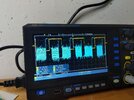I am building a setup to be able to read the reflected light from a laser beam with a photodiode, which I have never done before.
so I bought this photodiode and this transimpendance amplifier. But after wiring it up, I didnt get any useful readings from the TIA.
So I I reduced the voltage from my signal generator with a voltage divider and checked in on the oscilloscope.
But I I cannot interpret what I am seeing there:

sine

square

triangle
This is my setup

Is this a case of a broken module?
Is the voltage divider wrong? P-P amplitude from the signal generator is about 5.6V. I reduced this to around 500mV with the Voltage divider
I expected it to mirror the input signal at a simnifically increased voltage level.
Is using a waveform generator for testing the wrong approach?
I am a hobbyist and this is all a bit trial and error for me.
I know the photodiode works as it reacts to light when connecting directly to the oscilloscope.
so I bought this photodiode and this transimpendance amplifier. But after wiring it up, I didnt get any useful readings from the TIA.
So I I reduced the voltage from my signal generator with a voltage divider and checked in on the oscilloscope.
But I I cannot interpret what I am seeing there:
sine
square
triangle
This is my setup
Is this a case of a broken module?
Is the voltage divider wrong? P-P amplitude from the signal generator is about 5.6V. I reduced this to around 500mV with the Voltage divider
I expected it to mirror the input signal at a simnifically increased voltage level.
Is using a waveform generator for testing the wrong approach?
I am a hobbyist and this is all a bit trial and error for me.
I know the photodiode works as it reacts to light when connecting directly to the oscilloscope.



